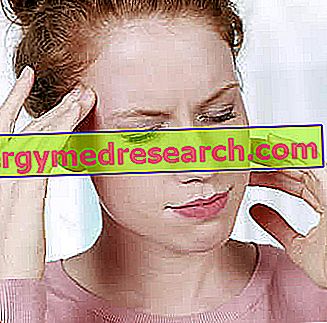Generality
Migraine with aura is a particular form of headache preceded or accompanied by a series of transient neurological symptoms . These reversible disorders more commonly include feelings of numbness, nausea, loss of appetite, mood changes, increased sensitivity to light or sound, visual blurring and scotomas. Migraine usually appears within about an hour of the end of the aura.

The diagnosis is clinical and is based on an accurate collection of clinical history and physical examination. In subjects who have episodes of migraine with infrequent aura, the treatment is exclusively symptomatic and involves the use of analgesics and anti-inflammatories from self-medication, such as ibuprofen and naproxen. In the case of recurrent or particularly serious attacks, a prophylaxis therapy is indicated , similar to that used for migraine without aura.
What's this
Migraine with aura is a primary headache (headache is therefore not caused by other diseases). In this condition, pain attacks can be heralded by prodromal symptoms, that is, by the sensation that the migraine is about to begin. Sometimes, these manifestations may persist even after the onset of the headache .
The average presence of migraine in the adult population is around 12% (18% in women and 6% in men); the aura precedes headache attacks in about a third of cases.
Causes
The causes of migraine with aura are not yet entirely clear, but it seems that genetic, vascular and neurohormonal factors are involved in the pathophysiology.
The main hypothesis holds that this particular form of headache depends on an alteration of the pain regulation system and on an anomaly in nerve signals .
The triggering of these particular mechanisms can induce various phenomena including a sudden constriction of the cerebral vessels, with a consequent reduction in the supply of blood in some brain areas. The physiological effect thus determined can justify the appearance of the migraine aura symptoms; the subsequent phase of vasodilation coincides, instead, with the onset of the actual headache.
This form of primary headache is more common in the female sex, it can affect all age groups and appears to be associated with a family predisposition.
Favoring and / or aggravating factors
The factors that can aggravate or trigger a migraine attack with aura are different and include:
- Emotional tension, anxiety, depression, stress or relaxation (as happens on weekends and on vacation);
- Fluctuation in hormone levels (menstruation, oral contraceptive use and menopause);
- Consumption of particular foods, fasting or unbalanced diet (eg abuse of sausages, aged cheeses, nitrites, glutamate, aspartame and chocolate);
- Exposure to the sun or too intense light;
- Consumption of alcoholic or caffeinated beverages;
- Smoking habit;
- Use of some drugs (eg vasodilators, oral contraceptives, etc.);
- Poor sleep quality or changes in sleep / wake rates;
- Excessive afferent stimuli (eg flashing lights, strong smells and noises);
- Climate changes;
- Too intense or particularly strenuous physical activities;
- Bad posture.
Symptoms and complications
Migraine with aura is preceded by malaise, bilateral characteristic visual symptoms and sudden changes in mood. Usually, these disorders occur immediately before the headache arrives and have a variable duration between 5 minutes and an hour.
The pain associated with migraine with aura can be so intense as to be incapacitating, preventing the usual daily activities and forcing bed rest.
Characteristics of migraine
The onset of migraine can already occur during the course of the aura or after a few minutes (but not beyond 60 minutes).
Migraine is one of the most common forms of headache. This is often perceived as a continuous, throbbing pain of moderate or severe intensity. During a migraine attack, the area where the headache is located can change position and progressively increase in intensity. The onset usually involves the anterior or lateral part of the head above the eye; later, the headache evolves into dull pain and the sensation of pulsation can become bilateral or spread to the region of the forehead and temples.
Migraine with aura manifests itself with recurrent attacks, which occur with a very variable frequency: from a few episodes in a year to 2-3 crises per week. The attack can last a few hours or, in the most serious cases, a few days (generally, they last from 4 to 72 hours).
Pain tends to worsen during activity and patients often report difficulty concentrating during crises. It follows that most people prefer to lie in a dark and silent room during attacks.
Aura characteristics
Auras are very different transient neurological disorders, which can affect vision, balance, muscle coordination, sensations or speech. These manifestations last from a few minutes to an hour and, in some cases, may persist after the onset of the headache.
Most commonly, the aura is characterized by visual symptoms, such as perception of sparkling geometric flashes (scotomas), loose bodies, dark spots, flashes of light (photopsia) and blind spots.
Other manifestations include blurred vision, image distortion, difficulty focusing, obscuring half of the visual field (hemianopsia) and photophobia (hypersensitivity to light). The visual aura is typically short lived and affects both eyes.
Sometimes, in addition to sight problems, symptoms of other nature may also appear, such as:
- Repulsion for food, nausea and / or vomiting;
- Tingling, numbness and reduced sensitivity of a limb or half of the body (typically, paresthesias begin in one hand, spread to the arm and may involve the ipsilateral half-life);
- Hypersensitivity or discomfort due to odors (osmophobia) and noise (phonophobia);
- Hindrance in the movements of an extremity;
- Aphasic type speech disorders (to be understood as difficulty in expressing oneself and articulating words).
The alteration of the state of consciousness (confusion, ataxia, lack of balance or disorientation) is less frequent due to the transient dysfunction of the brainstem.
These disorders last from a few minutes to an hour and sometimes the aura can occur without headache or precedes a mild painful symptomatology.
Migraine with aura can become chronic, therefore occur with a high frequency.
From the clinical point of view, different variants of migraine with aura are recognized (classical form, with acute onset, with prolonged aura, without headache etc.). In the isolated aura (or without headache), for example, the prodromal symptoms may occur without being followed by the migraine crisis. The rarest forms of migraine with aura are characterized by particular neurological symptoms, such as loss of strength up to paralysis of a part of the body ( hemiplegic migraine ) or other disturbances of balance and consciousness ( basilar migraine ).
Diagnosis
If the migraine with aura is very intense, does not respond to common analgesics or becomes a habitual disorder, it is good to consult your GP or neurologist for a correct evaluation.
The diagnostic assessment begins with the collection of anamnestic data (ie relating to the clinical history and symptoms). Therefore, the person is invited to describe the intensity and location of the pain, the frequency of the attacks and any disturbances felt before or during crises. The doctor can ask the patient if the headache:
- It presents itself with a throbbing pain of moderate or severe intensity, such as to prevent the performance of normal daily activities;
- It affects one side of the head (unilateral location);
- It is aggravated by physical activity or movement;
- It is accompanied by nausea and / or vomiting, increased sensitivity to light (photophobia) and / or noise (phonophobia) or other manifestations that can be traced back to the aura.
The evaluation continues with the objective examination, which allows the doctor to check some physical and neurological parameters, such as:
- Blood pressure and heart rate;
- Respiratory anomalies and presence of fever;
- Examination of the cervical muscles and the temporomandibular joint;
- Examination of motor, sensory, cerebral, cognitive and visual acuity functions.
The medical history and the physical examination are also useful to exclude other pathological conditions, which may be the basis of the onset of migraine with aura (attributable, that is, to other pathologies).
Based on the physician's judgment, the diagnostic pathway can make use of more in-depth diagnostic investigations, such as computed tomography (CT), magnetic resonance imaging and electroencephalogram (especially in children). Further tests may also include blood tests, cervical spine x-ray, lumbar puncture, ecodoppler and complete eye examination.
To help the doctor identify any triggering or aggravating factors, it may be useful to keep a " headache diary ", where to record the characteristics of migraine attacks: time references (date and time), description of pain (type, location, intensity, duration and frequency), medications taken, foods consumed, activities carried out before its appearance etc. The compilation of this register can be useful both to monitor the progress of migraine attacks and to determine the effectiveness of any therapeutic approach undertaken.
Therapy
Migraine with aura can seriously compromise quality of life, but some lifestyle changes (eg habits related to sleep or diet) and available treatments may limit the discomfort.
The first step to take to manage and prevent migraine with aura is to reduce or, if possible, eliminate the triggers . If the control of these stimuli is ineffective and if the pain is so intense that it prevents the performance of normal daily activities, it is possible to resort to drug therapy .
In any case, the most appropriate approach must always take into account the individual indications established by the doctor, formulated in relation to the extent of the disorder, the symptoms and the personal needs of the patient.
Symptomatic treatment

Among the drugs most used in symptomatic therapy are non-steroidal anti-inflammatory drugs (NSAIDs) and triptans : both these types of drugs are able to limit the painful attack, but generally they are not able to have effects on the aura.
Preventive treatment
When the migraine with aura recurs often (at least 5 seizures per month) or if the symptoms are very serious, a neurologist who specializes in treating headaches may indicate a prophylaxis therapy, aimed at reducing the frequency and severity of attacks. This type of drug treatment involves taking regular medication, often on a daily basis. The main classes of medicines are in part similar to those used for migraine without aura and include:
- Beta blockers and calcium channel blockers (modulate the tone of blood vessels and regulate the mechanisms involved in pain);
- Antidepressants (they act mainly on serotonin receptors);
- Antiepileptics (they act on the pain threshold and on the brain excitability).
Some advice
Some behaviors can help to alleviate the pain of the migraine attack with aura. These include:
- Isolate yourself from lights and sounds;
- Take a hot bath or shower;
- Lie down or take a little nap. Close your eyes and try to release tension in your back, neck and shoulders;
- Apply an ice pack on the painful area of the head (forehead, temples or back of the neck);
- Exert gentle, constant and rotating pressure on the site of pain with the index finger and / or thumb. Maintain the pressure for 7-15 seconds, then release. Repeat if necessary.



